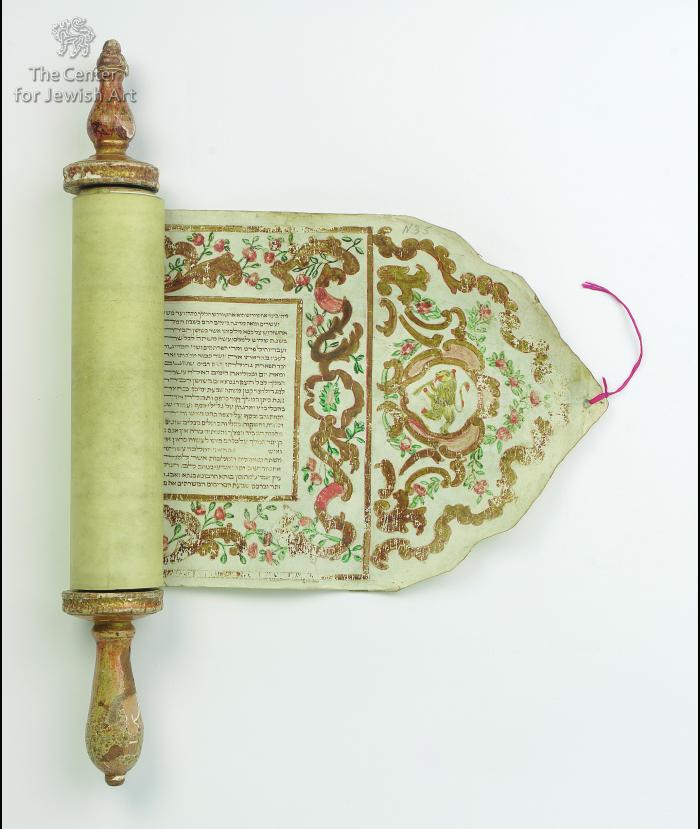Obj. ID: 37885 JML Ornamented Esther Scroll with a Coat of Arms, Ancona, 1831

The length of the sheets in the sheets: 1) ca. 720 mm, 2) 440 mm, 3) ca. 460 mm, 4) ca. 375 mm, 5) ca. 300 mm (the left edge of the sheet is stitched to the roller).
Dimensions of the selected details in the scroll:
- text column: 91x68 mm;
- text panel: 102x155 mm;
- decorations in the margins: 35 mm;
- frames around the panels and in the margins: 3 mm;
- an average letter: 2 mm (height);
- an average letter in col. 18: 4 mm (height).
The benediction sheet: 200x425 mm.
The roller: ca. 390 mm.
The right edge of the first membrane is trimmed into a decorative shape; to its tip, a short ribbon is attached. The opening part is filled with a floral ornament that surrounds a cartouche with a coat of arms composed of a rampant lion holding a palm branch (?) in its front legs. The Hebrew text of the Book of Esther is inscribed in double panels that are separated by floral decoration. The upper and lower margins adorn repeating motifs, similar to these filling the opening part of the scroll. In the last panel, there is a colophon in which the scribe - Gamaliel the son of Yeshaya Menachem Zalman of Lugo - says that he copied the megillah for Shlomo Moshe Sonino.
A separate benediction sheet is added to the scroll; it is decorated with the same motifs as the scroll itself.
The scroll is mounted on a wooden roller that originally was painted.
The Book of Esther in Hebrew with a separate sheet including the benedictions recited before and after the Megillah reading and liturgical poems for Purim: עמי נשיר כולנו ("Ami nashir kulanu") and קוראי מגילה ("Korei megillah")
The scroll is formed of 5 sheets containing 21 columns of text with 21 lines (+ one column containing the colophon), except for col. 18 with 11 lines divided into two parts, and col. 21 with 18 lines.
The number of columns per sheet: no. 1 - 6, nos. 2 and 3 - 5, no. 4 - 4, no. 5 - 1 (+ the colophon).
The text is inscribed in the Hebrew square Italian script, in black ink, on the flesh side of parchment membranes that are thick and stiff. The side of the text and decorations is bright, while the other side is rather yellow.
It seems the text was copied by two scribes.
The letters ח (Es. 1:6) and ת (Es. 9:29) are enlarged. Other enlarged and diminished letters are included in col. 18.
There are some corrections and erasures in the text (e.g. in col. 6).
In the text, numerous elongated letters are incorporated.
The ruling - horizontal and vertical lines - is made with a hardpoint, along with the sheets.
The pricking is invisible.
The sheets are stitched.
The benediction sheet: all four benedictions and two poems are inscribed in the square script. Words ברוך are separated from the rest of the formulas. Before each text, a heading is added.
The last column in the scroll - no. 22 - includes the colophon of the scribe, Gamaliel the son of Yeshaya Menachem Zalman of Lugo:
מגילה זו כתבתי אני גמליאל
בלא''א'' ישעיה מנחם
זלמן מעיר לוגו בן י''ב שנים
להגביר הנעלה זקן ונשוא פנים
מר זקני ר' שלמה משה
סונינו היו אכיר
פה אנקונא
יע''א היום כ''ב לח' שבט שנת
דרש טוב לעמו
לפ''ק
Some remains of the sketch in pencil are still visible.
The Esther scrolls only rarely bear colophons or other scribal notes.
Unknown

